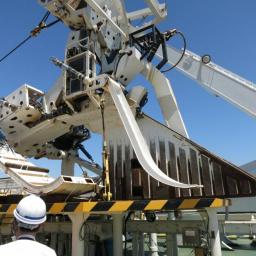
Japan is home to an extremely important vessel:
it's the ship that lays the trans-oceanic cables that form the backbone of telecommunication, that is, the Internet. Satellites play an increasingly important role in shipping packets, but the bulk of the connections pass through underwater cables.
The laying process involves checking submarine geography to avoid steep rises and falls, and then calculating tide movements and the trajectory of the falling cables in relation to ship speed, the firm said. Only then are the cables laid and buried by the Subaru, which was built in 2000.
The cables, encased in sheaths of rolled metal, are laid and buried deep - at an average of 1,000-1,500 meters below the sea surface - so as not to interfere with fishing vessels. However, the Subaru can lay cables much deeper at 8,000 meters below the waves.
Speaking of backbones, the Internet's backbone - in the
protocol sense of the word - remains unfortunately vulnerable. The issue is the Border Gateway Patrol protocol, at the heart of routers everywhere. And its vulnerabilities are not being tackled with a level of effort commensurate with their importance.
Large routers operated by Internet service providers and major corporations use BGP to figure out how to get data between different places. Each of these major routers turns to others like itself-ones operated by other companies-for the information it needs to most efficiently dispatch data to its destination. Companies operating the routers manually choose which other routers theirs will trust.
Unfortunately, BGP doesn't have security mechanisms built in that allow routers to verify the information they are receiving or the identity of the routers providing it. Very bad things can happen when routers spread incorrect information about how to route data, intentionally or otherwise.
That problem has been known for decades. It was the basis of the hacking group L0pht's 1998 claim before Congress that they could take down the Internet in 30 minutes. But incidents that have illuminated BGP's flaws have prodded some security companies to take it more seriously.
Read more about it
at Technology Review, who is reporting on one of the important presentations revealed at the 2015 Blackhat Conference
discussed here on |. earlier this month.
 Japan is home to an extremely important vessel: it's the ship that lays the trans-oceanic cables that form the backbone of telecommunication, that is, the Internet. Satellites play an increasingly important role in shipping packets, but the bulk of the connections pass through underwater cables.
Japan is home to an extremely important vessel: it's the ship that lays the trans-oceanic cables that form the backbone of telecommunication, that is, the Internet. Satellites play an increasingly important role in shipping packets, but the bulk of the connections pass through underwater cables.